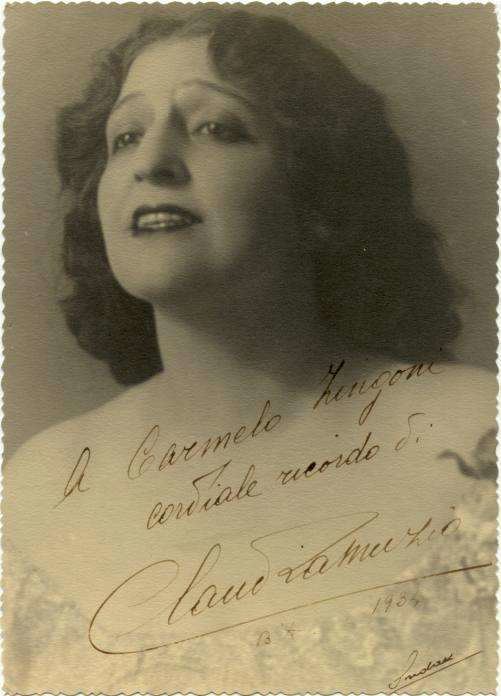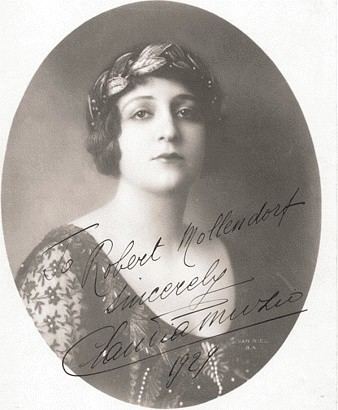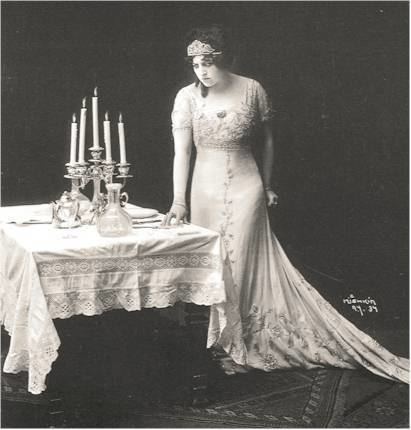Name Claudia Muzio | Died May 24, 1936, Rome, Italy | |
 | ||
Albums Great Band With Great Voices Similar People Licinio Refice, Renata Tebaldi, Amelita Galli‑Curci, Tito Schipa, Lorenzo Molajoli | ||
Soprano claudia muzio baciami 1917 18
Claudia Muzio (7 February 1889 – 24 May 1936) was an Italian operatic soprano, whose international career was among the most successful of the early 20th century.
Contents
- Soprano claudia muzio baciami 1917 18
- Soprano Claudia MUZIO Crisantemi 1920
- Early years
- Career
- Last years
- Recordings
- References

Soprano Claudia MUZIO: Crisantemi (1920)
Early years

Born in Pavia, Muzio was the daughter of an operatic stage manager, whose engagements during her childhood took the family to opera houses around Italy as well as to Covent Garden in London and to the Metropolitan Opera in New York. Her mother was a choir singer, Giovanna Gavirati. Claudia Muzio arrived in London at the age of 2 and went to school there, becoming fluent in English, before returning to Italy at the age of 16 to study in Turin with Annetta Casaloni, a piano teacher and former operatic mezzo-soprano who had created the role of Maddalena in the world première of Verdi's Rigoletto. Muzio then continued her vocal studies in Milan with Elettra Callery-Viviani.
Career

Muzio made her operatic début in Arezzo (15 January 1910) in the title role of Massenet's Manon, and despite her youth she made rapid progress in the opera houses of Italy, leading to débuts at La Scala in Milan in 1913 (as Desdemona in Verdi's Otello), in Paris (as Desdemona) and in London at Covent Garden (as Puccini's Manon Lescaut) in 1914; she stayed on in London to sing other roles including Mimì and Tosca (both with Caruso). She was invited to the Met in New York in December 1916 (for Tosca) and was so successful that she continued to appear there during six successive years. It was at the Metropolitan that Muzio created the role of Giorgetta in Il tabarro, in the world première of Puccini's triple bill, Il trittico, on 14 December 1918.

She established a special relationship with audiences at the Teatro Colón in Buenos Aires, where she first appeared in June 1919 (in Catalani's Loreley). From then until 1934 she sang there in 23 different operas, becoming known as "la divina Claudia". Between 1922 and 1932, she appeared regularly in Chicago (after falling out with the management at the New York Met).

On 15 October 1932, she performed the title role of Tosca to inaugurate the new War Memorial Opera House in San Francisco. Other notable roles in her career included the title role in Aida, Santuzza in Cavalleria rusticana, Maddalena in Andrea Chénier, and Leonora in Il trovatore (all in New York), and also Violetta in La traviata and Leonora in La forza del destino (in Chicago and Buenos Aires). Her last and according to some critics her greatest role was in Rome in 1934 as Cecilia in the opera of that name written for her by Licinio Refice. Her most popular role, however, was Violetta, in which she was considered unsurpassed throughout the Latin opera world (Italy, Spain, South America).
Muzio was noted for the beauty and warmth of her voice, which, although not particularly large, acquired a considerable richness of tonal colouring as she grew older. Her performances were sometimes criticised for excessive use of dynamic extremes, including her exquisitely expressive pianissimo singing. She remained modest and even reclusive despite her increasing fame and wealth.
Last years
In her later years, Muzio experienced some financial anxiety after losing money through the extravagance of a manager/rumoured lover and then in the Wall Street crash. In 1929 she married Renato Liberati, seventeen years her junior. In 1930 she started to experience some health problems, but continued singing and recording. On 24 May 1936, after a short illness, she died in a Rome hotel of what was officially described as heart failure, aged 47. She is buried in the Cimitero del Verano in Rome.
Recordings
Muzio is represented by recordings from various stages of her career, but few of them are from the period of her greatest successes in the late 1920s and early 1930s. She also recorded primarily for two companies whose distribution was limited and erratic: Pathé and Edison. Muzio's Pathé discs are of mixed quality due to Pathé's problematic recording process – artists recorded to cylinder masters which were then pantographically transferred to disc masters for making stampers, and frequency range loss and distortion often occurred during the cylinder-to-disc processing. Her Edison recordings, however, represent not only some of the best operatic recordings released by that company, but also Muzio's power and ability to project her personal intensity through the difficult acoustic recording process. She was aided at Edison by chief recordist Walter Miller and staff conductor Cesare Sodero.
